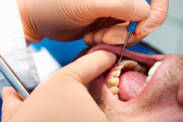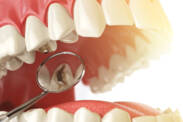Diseases of the oral cavity
Diseases of the oral cavity include
Diseases of the oral cavity are associated with problems of the teeth themselves, as well as disorders and diseases of the jawbone and the jawbone, while oral diseases also affect the gums, periodontium, tongue, palate and internal mucous membranes, as well as the lips. Within the oral cavity there are also salivary glands which have very important functions within the digestive system and these paired glands can also be affected by various inflammatory and non-inflammatory diseases which can cause other complications within the oral cavity.
The oral cavity as such is formed by the oral vestibule and the oral cavity proper, which are separated by the border of the connected upper and lower oral arches. Thus, within the oral vestibule are all the tissues in front of the teeth and within the oral cavity, i.e. the lips, the vestibular arch and the upper and lower dentition. The oral cavity itself is made up of the gums, teeth, tongue, palate and the small and large salivary paired glands on each side are also found here. The outer boundary is the jaws.
Different types of tissues are found in the oral cavity and its different parts. These are either hard bony tissues or cartilaginous tissues, connective tissues and also soft tissues covered with an overlying layer of mucous membrane and epithelial cells. This part of the body is affected by tumour, non-tumour, inflammatory, non-inflammatory, congenital and acquired diseases; some diseases and disorders affect several parts of the oral cavity or are related to each other, while others are localised to a particular type of tissue or to a part of the oral cavity.
Diseases of the tongue
The tongue is a muscular organ located in the oral cavity on the underside, while it is covered with mucous membranes that are densely innervated. Through the tongue, a person can taste the food he or she receives, where the tongue, like the palate, houses the taste buds. In addition, the tongue is also involved in speech articulation and aids in the production of sounds. Thanks to the muscles, its flexible movement is possible, with the tongue consisting of a root, a back, a margin and a tip.
Diseases of the tongue can be of both inflammatory and non-inflammatory types. Common inflammations include both superficial and deeper inflammations, such as glossitis, abscessitis, traumatic ulceration, infectious inflammation, inflammation of the tongue caused by prolonged and chronic irritation, or inflammation involving not only the tongue but also other mucous membranes and lining of the oral cavity, most commonly the gums and palate. These are stomatitis. In some cases of inflammation, there is even ulceration or the formation of necrotizing abscesses.
In addition to inflammatory diseases, the tongue can also be affected by various diseases of its surface papillae, such as hypertrophy, black tongue, black hairy tongue or atrophy of the tongue papillae. The tongue is also affected by various anomalies of shape or size, such as flaccidity and atrophy of the muscles of the tongue or hypertrophy of certain parts of the tongue. Aphthous or other ulcers may also appear on the mucous membrane, sometimes even tumours and cancerous deposits. The so-called burning tongue syndrome is also quite common.
Dental diseases
Human dentition is made up of teeth, and the development of teeth begins during pregnancy. Humans are first born with temporary dentition, which consists of milk teeth, and eruption begins around the 6th month of life. It is not until around the age of 6 that the permanent dentition is erupted. However, dentition is not only the teeth, but also the entire downstream fixation apparatus of the teeth, soft and supporting tissues and structures. A great many diseases of the dentition are either directly related to the gums or the jaws, for example, or even have their cause in these other parts of the oral cavity. The most important function of the dentition is chewing and processing food for the digestive system.
Dental diseases are most often related to the hard tissues of the teeth, whether they are disorders of tooth development and growth or problems caused by tooth decay. Common developmental disorders include various forms of edentulousness, supernumerary teeth, various stains and coatings on the teeth, as well as abnormalities in the shape or size of the teeth; in children there are especially problems with tooth eruption and teething. Excessive tooth wear, tartar and problems with the enamel or dentin of the teeth are also major problems.
Within the dentition, various defects, diseases and anomalies also affect other tissues and parts of the teeth or the entire dentition. These include, for example, inflammations of the pulp, abscesses of the pulp, necrotic processes such as gangrene, and possibly also pulp calcifications and abnormal overgrowth of hard tissue. Dental abscesses in soft tissues may also occur. The supporting tissues are affected by anomalies of relative position, various types of defective bite, anomalies in the position of the teeth, or atrophy of the alveolar ridge.
Gum and periodontal diseases
The gums and periodontium, which is the hanging and fixing system of the tooth, are also closely related to the dentition. The periodontium is actually the tissue surrounding the tooth and fixing it into the jaw, while the periodontium itself consists of the gingiva, dental cement, alveolar bone, which forms the bone bed, the dentition and the gingival sulcus. The gingiva is covered with epithelium and mucosa, which is similar to the mucosa of the oral cavity. Several pathological problems and diseases of the gingiva are also related to the periodontium and dentition.
Among the very common problems are gingivitis, which can take the form of acute, chronic and also abscess inflammation. The most common inflammation is acute gingivitis caused by bacteria from plaque or a viral infection. In addition to the gums, inflammation also affects, for example, the dentition, which can also have both acute and chronic forms and also a form with necrotizing tissue, when an abscess is formed. Early treatment is very important, otherwise there is a risk of the inflammation spreading to other tissues.
The gums may also be affected by various changes such as atrophy or hypertrophy, which may or may not also be related to inflammatory processes in the oral cavity. The periodontium itself is most often affected by periodontal disease, i.e. disease of the hinge apparatus of the tooth. Here too, the late stage is almost untreatable and extends to other teeth within the dentition. The gums as well as the alveolar ridge are also affected by various hyperplasias, granulomas and, in some cases, cysts or tumours.
Temporomandibular disorders
The jaw consists of an upper and a lower part, and the lower part is also called the canine. It is the only movable bone of the skull, which is connected to it by the jaw joint. The maxilla also forms the palate and separates the nasopharynx from the oral cavity. The alveolar process of the maxilla houses the maxillary dentition, while the alveolar process of the mandible houses the mandibular dentition. Temporomandibular disorders are often related to the dentition itself and also to the oral cavity.
Jaws are affected by several types of diseases. These include position and size anomalies, such as hyperplasia or hypoplasia of the upper and lower jaw, malocclusion, excessive protrusion of one of the jaws or other malocclusion, or "bad bites", anomalies. Abnormalities and disorders also affect the temporomandibular joint, possibly in the form of increased wear, Costen's syndrome, temporomandibular joint pain dysfunction syndrome or myofascial pain dysfunction syndrome.
The bones of the jaw are also affected by various cysts and tumours, which can cause partial dislocation or other pathologies in advanced stages. Sometimes there is also penetration of tumour growths or cysts into the surrounding cavities. Acute and chronic inflammations of the jaw are also very common, for example, alveolitis, osteomyelitis or osteitis of the jaw are the most common. Developmental disorders and defects, or exostosis of the jaw bones or malignant fibrous histocystoma, may also occur.
Salivary gland disorders
Salivary glands are part of the oral cavity and their main activity is the secretion of saliva. Saliva moistens the oral cavity itself and helps to coat the food, containing enzymes that in turn allow the food to be digested efficiently within the digestive tract. Within the oral cavity are large and small salivary glands. The large ones are three paired and are housed under the mucous membrane and skin. In addition, there are also a number of smaller glands within the submucosal ligament of the oral cavity, both of which are affected by various diseases and disorders.
Common salivary gland disorders include problems with secretion. For example, disorders where there is a decreased or increased production of saliva or other secretions, including hypoptyalism, ptyalism, xerostomia, sialosis and other disorders that arise from an allergic or infectious factor. The salivary glands are also affected by various tumours, whether benign, such as pleomorphic adenoma, or malignant epithelial tumours, which may also indicate cancer.
Like other parts of the oral cavity, the salivary glands are subject to inflammation, both acute and chronic, such as sialoadentitis or parotitis. Non-inflammatory disorders include hypertrophy and atrophy of the salivary glands, which are sometimes associated with other diseases in the body. In the context of diseases affecting mainly large but sometimes also small salivary glands, mucoceles, sialolithiasis, abscesses, fistulas and various non-infectious swellings of the salivary glands are also common.
Diseases of the palate and lips
The palate and lips are part of the confines of the oral cavity. The lips are the entrance to the oral cavity, while the palate is the roof and separates the oral cavity from the nasal cavity. The lips are a separate organ that is paired, richly vascularized and innervated, and largely composed of musculature, the so-called round mouth muscle. The palate is composed of hard and soft parts, so that it contains both bone tissue and ligament. Several diseases of the lips and palate are related to each other, but they are mainly related to the inner mucous membranes of the oral cavity.
Diseases affecting the palate and lips include a number of congenital defects and disorders, such as clefts. It can be a single cleft lip or cleft palate, or a combined cleft of both parts. Various cysts, tumours and deposits are also common, for example, neodontogenic cysts, but also cysts forming on the papillae of the palate. Cancers affecting both the palate and the lips are also common.
The palate is also afflicted by several inflammatory diseases such as stomatitis, granulomas, xanthomas or oral mucinosis. Aphthae, manifested by minor boils, are also a relatively common disease occurring on the palate. These may also be found on the lips. The lips are also affected by various infectious viral diseases caused by herpes viruses, as well as chelitides, or inflammations. Similarly to the palate, both aphthae and tumours occur on the inside of the lips.














